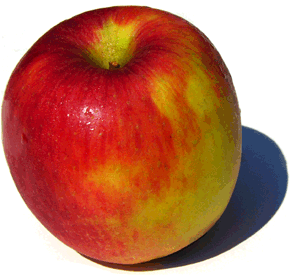
 |
|||||
|
|
|
|
|
|
|
Apples - Good as Goldby Catherine Fallis MS |
|
 Apples, like grapes for wine, come from all over the world. In fact, apple trees and grape vines thrive in similar growing conditions, and in many areas are competing for the same land. According to the online Food Museum, apples have been cultivated for over 3,000 years, probably originating in the Baltic region, and became a staple in Europe as one of the few fruits that would keep over the winter. Here is a bit to chew on from the Dole Food Company's online Fruit and Vegetable Encyclopedia:
Apples, like grapes for wine, come from all over the world. In fact, apple trees and grape vines thrive in similar growing conditions, and in many areas are competing for the same land. According to the online Food Museum, apples have been cultivated for over 3,000 years, probably originating in the Baltic region, and became a staple in Europe as one of the few fruits that would keep over the winter. Here is a bit to chew on from the Dole Food Company's online Fruit and Vegetable Encyclopedia:
The Fruit and Vegetable Encyclopedia states that there are more than 7,000 varieties of apples grown in the world. Of the 2,500 varieties grown in the U.S., more than 90% come from only 16 varieties, and 8 of these make up 80%. The most popular variety in the U.S. is the Red Delicious. Golden Delicious takes second place as our favorite snacking apple, with McIntosh, Granny Smith, Jonagold, and Braeburn close behind. As a wine educator, I am always comparing grapes to apples when teaching about "varietals." People are so intimidated by wine. I like to put people at ease right away, and I try to do so by simply explaining that Chardonnay and Cabernet Sauvignon are two different varieties of grapes, just as Granny Smith and Red Delicious are two different varieties of apples. It takes just seconds for this morsel to sink in, and once it does, they relax, smile, and say, "go on." If consumption is any proof, intimidation is not an issue with apples. In this country, we consume almost twenty pounds of fresh apples each, per year. Europeans consume more than twice that number-about forty-six pounds each, per year. Is that how they manage to stay so slim despite the cheese and foie gras? Apples are highly nutritious, with five grams of fiber, no fat, no cholesterol, and no sodium. At an average of only 80 calories each, with 20% of the daily fiber needed by our bodies to keep cholesterol in check and to facilitate digestion (one apple has more fiber than an entire head of iceberg letttuce), it is no wonder our medical establishment recommends "an apple a day." Also, according to the Washington State Apple Commission web site, apples are an excellent source of carbohydrate energy as well as potassium, which regulates the body's fluid balance and neuromuscular activity. Further, apples, like wine, contain "naturally occurring chemicals called flavonoids, which may reduce the risk of heart disease and inhibit development of certain cancers." |

The Michigan Apples web site notes health-benefits of apples as well: "Apples are rich in flavonoids, a class of antioxidant phytochemical, especially one member called quercetin. A Finnish study published in 1996 in the British Medical Journal found, after following more than 5,000 Finnish men and women for a quarter of a century, that the consumption of apples and onions was inversely associated with total coronary mortality." They go on to note that "researchers at the University of California at Davis (UC Davis) found that phenolic compounds (phytochemicals) in apples acted as antioxidants against LDL (low-density lipoproteins), the damaging portion of cholesterol in the bloodstream. The research results were published in the April 16, 1999, issue of Life Sciences." And finally, they point out that the high levels of Vitamin C, or ascorbic acid, found in fresh apples has antioxidant properties and therefore also has positive effects on the cardiovascular system. All this good news is cause for celebration. Go out and pick up some apples at your local supermarket, or order online from numerous web sites that deliver farm-fresh to your door. Their quaint, down-home names like "Farm Boy," "The Apple Man," or "Rocky Mountain Fruit," are as inviting as their offerings. Excellent snacking apples include the tart, crisp, and juicy Granny Smith; the snappy Pippin; the mildly sweet and softly textured Fuji or Gala; the deep, sweet, and spicy Ida Red; and the sweet-tart and juicy trio of Jonathan, McIntosh, and Winesap. If your idea of celebration involves time in the kitchen, here are a few recipes to get your juices flowing. Because apples, like grapes, have different physical as well as flavor characteristics, remember to select the type that will best stand up to the task.
For pies:
For baking: To prevent browning, dip slices in a mixture of lemon juice and water, or in orange or pineapple juice. |
|
Copyright © 2008 Epicurean.com & Fezziwig Publishing All rights reserved |